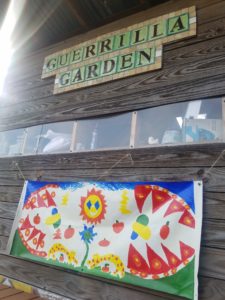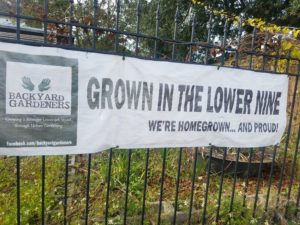 By Heather Smith, Senior Program Officer-Justice, The Field Foundation
By Heather Smith, Senior Program Officer-Justice, The Field Foundation
I didn’t set out to become an urban planner. I stumbled across it in college. As the deadline approached to choose a major. I was flipping through the course catalog and realized that almost all the courses I had taken to date added up to an urban studies major. Aha! And that’s when another realization set in. I adore analyzing systems. Transit. Parks. Housing. Garbage pickup. But what I encountered in real life urban planning, which the PLACES Fellowship highlighted, was a more insidious set of systems—institutional racism in the form of segregated housing systems. Planning systems that inevitably place toxic sites near poor communities of color. And a philanthropic system that all too often reinforces the institutional racism we all live under by “other-izing” the folks they are trying to help, not listening to their ideas for change, and funding top down efforts. All of this results in a system that consistently favors the white male dominated way of doing business. And for those questioning these systems it creates yawning gaps between how we operate on the surface and what we are really thinking. This impedes the work we do in philanthropy.
Which brings me to New Orleans. My PLACES Fellowship’s fourth and final site visit in December 2017 brought us to a city soaked in history, culture and food, and so many questions of racial equity. A place that shouldn’t work but does. Water above, dry land below. An implausible mix of culture, celebrations, community and food traditions all brewed together in a fantastic stew. Hurricane Katrina brought on the collapse of many of those urban systems, thus the story of Katrina now defines this city. In 2005 many residents lost everything. When every system failed-from transportation, to health care to the levies, flood victims were left only with our shared human systems.
Love.
Resilience.
And Justice.
The human resilience left behind was immensely powerful. And that continues, fourteen years later. Driving through the Lower 9th Ward where four out of five lots on each block are vacant made me realize how nearly every structure I saw was rebuilt with love and resilience, carving a path to justice. We heard stories of agony, of displacement, lost relatives, and a tightly woven culture in the Lower 9th Ward ripped apart by the flood. Residents talked about losing relatives who died far from home in Houston or losing their communities with five generations of family who all lived within a few blocks of each other. Yet through the tears I heard the beating heart of love and resilience. It keeps on through the loving welcome that Warrenetta Cheneau-Banks of Lower 9 Resilient brings to every volunteer group that visits even 14 years after the hurricane. It comes through in the tears she shed as she repeated her Katrina story for us. It lives on in the Backyard Gardeners Network which is doing “guerilla gardening.” They are staking territory in vacant lots and using food to revitalize the neighborhood while preserving its cultural heritage. They are cultivating stories of resilience and love by bringing young and old together over food. That resilience and love is what shapes the place today and is what endured for me long after my return home.
Listening is intrinsic to urban planning. This is also true in my current work in philanthropy. The Field Foundation’s new grant making direction has shifted its focus to community empowerment through justice, art and leadership investment. I am leading our justice portfolio which is focused on upstream, root cause issues with a racial equity lens. The foundation shifted its grantmaking to intentionally fund and listen to people of color in community understanding that narrative and storytelling is a key piece of justice. Justice is so broad it is hard to grapple with sometimes. Yet I’m trying to listen for it and to understand what it means through nearly every conversation I have—particularly those in divested neighborhoods and those voices of color that have been most marginalized. And I’m learning that sometimes the most powerful thing I can do is put down my phone, set aside my to do list, and listen.
 Many of the issues within justice are so urgent and so pressing that it is a challenge to build the space to think and reflect. Yet often the work of equity is how you do your work. It is not that the results or end product aren’t important. But there’s a craft to how one approaches the work. We all want “impact” in philanthropy but that can be elusive. But what we can do today is ground ourselves in equity. Dig deep. Find resilience from others and put equity at the center. Sometimes in the day to day that means going to someone’s office rather than having them travel downtown. For me it also means building space and time on the calendar to listen to what people in community are saying. Roxanne Franklin of the city of New Orleans talked about Equity New Orleans—the city’s approach to integrating racial equity through all city departments. As a Chicagoan coming from a patronage-based system I was incredulous and somewhat skeptical about this effort. However, she said that they couldn’t have gotten to this work without two years of racial healing work. This reinforced for me that the long road to racial equity is in the listening and building resilience.
Many of the issues within justice are so urgent and so pressing that it is a challenge to build the space to think and reflect. Yet often the work of equity is how you do your work. It is not that the results or end product aren’t important. But there’s a craft to how one approaches the work. We all want “impact” in philanthropy but that can be elusive. But what we can do today is ground ourselves in equity. Dig deep. Find resilience from others and put equity at the center. Sometimes in the day to day that means going to someone’s office rather than having them travel downtown. For me it also means building space and time on the calendar to listen to what people in community are saying. Roxanne Franklin of the city of New Orleans talked about Equity New Orleans—the city’s approach to integrating racial equity through all city departments. As a Chicagoan coming from a patronage-based system I was incredulous and somewhat skeptical about this effort. However, she said that they couldn’t have gotten to this work without two years of racial healing work. This reinforced for me that the long road to racial equity is in the listening and building resilience.
So here are my main takeaways from the PLACES Fellowship—and particularly the work of racial equity;
1) Stakeholder engagement is the work. One grantee was pitching an idea to me in justice during which she outlined the end goals and then talked about how she was engaging new racial and ethnic groups, and I said, “This IS the work.” The process of racial equity, and stakeholder engagement can be a powerful lever for change. Whether it is making physical space for community, granting dollars for community to have space to heal, or ensuring that there is a round table instead of the head of a table.
2) Take time to truly listen to the place. Funders often miss the stories that reside deep within the place. And often resilience, love and justice are in the listening. Every place and its soil is full of preconditions containing these racialized unequal structures and we must make it a practice to understand the stories on the road to justice.
3) Reflection is vital. When we are stressed out, we go to the status quo. Reflection often gets lost in the busyness. Yet being intentional about recording lessons learned can teach us how to deepen our listening. As I reflect on the PLACES Fellowship experience, the word that rises is gratitude: Gratitude for the grantees who are out in community making a difference every day, gratitude that I can actively wrestle with the big questions of justice and racial equity, and gratitude for the PLACES Fellowship for activating these conversations and building space for racial equity.
An enduring image for me is Lee Circle in New Orleans with the newly toppled Robert E. Lee statue now missing. Inside the traffic circle surrounded by grass now stands a statue-less pedestal. More than symbolic, the magnitude of the shift in the landscape of that place is palpable. Perhaps there are fissures within this structural racism. This image gives me a greater urgency to work towards racial equity. The PLACES Fellowship has helped me sharpen the tools to dig deeper, and I will carry these lessons with me as I learn to listen even more. These racialized systems can be altered—statues will fall, and worlds can change. They just need acts of love and resilience leading toward justice. Let’s listen for it.
Catch up on our last Going PLACES blog here.
 Heather Smith, PLACES Alumni 2017
Heather Smith, PLACES Alumni 2017
Senior Program Officer – Justice
Heather reviews and evaluates grant requests from Chicago area not-for-profit organizations. In addition to conducting site visits with applicants and making funding recommendations, Heather also manages the foundation’s internship program. Prior to Field, Heather served as the planning director for the congress for the New Urbanism and coordinated the Metropolis Plan activities for Chicago Metropolis 2020. She also received an American Planning Association fellowship to advance sustainable development and planning in the U. S. Senate. Heather is a member of Chicago Women in Philanthropy and the American Planning Association and serves on the Chicago Metropolitan Agency for Planning Land Use Committee. Heather is also an adjunct faculty member in DePaul University’s Geography Department and holds a master’s degree in urban planning from Columbia University and a bachelor’s degree in urban studies and Japanese from Macalester College. Heather enjoys biking, sailing, and traveling in her spare time.
